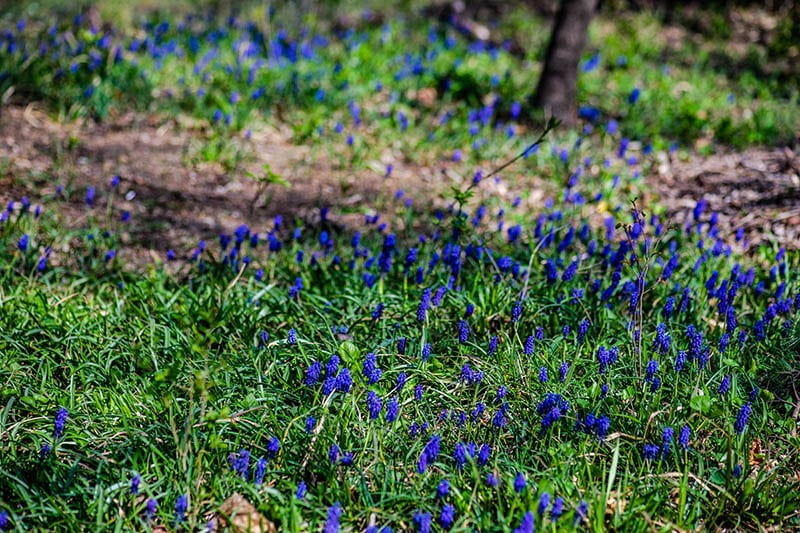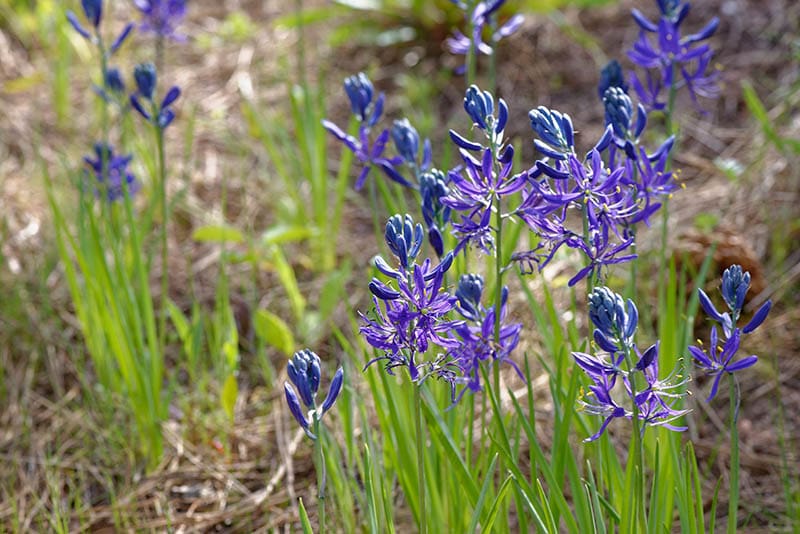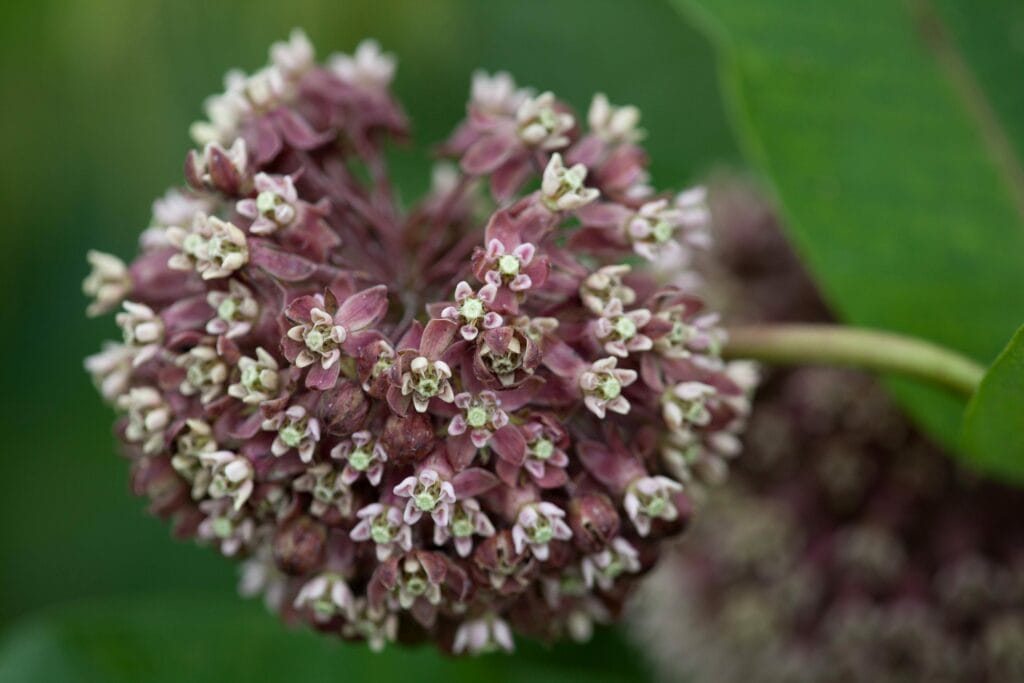10 Wildflowers That Grow in Missouri (Identification Guide With Pictures)
-
Pete Ortiz
- Last updated:

Missouri is a state that’s known for its beautiful outdoor spaces, so it’s no surprise that the wildflowers that bloom in its valleys, plains, and forests are just as stunning. If you’re looking for a way to take in the beauty of this region, then you should consider a wildflower excursion.
From the popular wildflowers of the Ozark Mountains to the rare finds of the Loess Hills, Missouri has something for everyone. With this guide, you’ll be able to identify the most common and beloved wildflowers of the region and discover some of the best spots in the state to view them. Let’s discuss.
The 10 Wildflowers That Grow in Missouri
1. Wild Hyacinth

| Scientific Name: | Camassia scilloides |
| Average Height: | 12-36 inches |
The wild hyacinth is a beautiful native wildflower that is found in a variety of habitats, such as prairies and open woodlands. It has a unique, drooping bluish-colored leaf and displays large, white to pale yellow fragrant flowers from June to August. This drought-tolerant plant grows up to 3 feet tall and has a deep taproot that helps it survive in times of drought. Wild hyacinth is an important plant for pollinators like bees, butterflies, and hummingbirds, and its flowers are also edible. In addition to its beauty, the wild hyacinth is an important part of the Missouri ecosystem, providing food and shelter for a variety of wildlife.
2. Missouri Bluebonnet

| Scientific Name: | Lupinus texensis |
| Average Height: | 12-18 inches |
The Missouri bluebonnet is one of the state flowers of Missouri and it definitely stands out from other plants. This perennial plant grows to be about 2 feet tall and has gorgeous blue flowers. The flowers are usually pollinated by bees, but they also can be fertilized with nitrogen solutions, and you can buy them at your local home improvement store or plant nursery.
The leaves are compound and have slightly serrated edges, making them good at filtering water droplets from the air. The Missouri bluebonnet is an important part of Missouri’s natural landscape, and it is an important source of food for bees and other pollinators. It is an impressive sight to behold when it is in full bloom, and its striking blue flowers will definitely call attention to your garden or yard.
3. Creeping Jasmine (Asiatic Jasmine)

| Scientific Name: | Trachelospermum asiaticum |
| Average Height: | 4-15 feet |
If you’re looking for a plant that is well-adapted to Missouri’s humid climate, look no further than creeping jasmine. The “Asiatic jasmine” is one of the most popular plants for landscapes and gardens. It’s low maintenance, has a long blooming period, and is great for covering large areas. The plant has glossy, dark green foliage and produces star-shaped white flowers in the summer. It’s pretty versatile and can be grown in areas from full shade to full sun. It is also drought tolerant and can be used as a ground cover.
It’s also great for erosion control due to its thick foliage and deep root system. The Asiatic jasmine is a low-maintenance and hardy plant that can be used in many different ways. This beautiful flowering shrub can grow up to 6 feet tall and its flowers are white and fragrant. It is easy to care for – just water it monthly and fertilize every other month with a high-nitrogen fertilizer. This lovely shrub makes a great addition to any garden, whether it be in a flowerbed, in a container, or outside.
4. Missouri Evening Primrose

| Scientific Name: | Oenothera macrocarpa |
| Average Height: | 2-4 feet |
The Missouri evening primrose is a unique and beautiful flower native to North America. This perennial flower grows up to 4 feet tall and has large clusters of fragrant, yellow flowers that open in the evening and close in the morning. It’s a drought-tolerant plant and grows best in full sun with well-drained soils. It is slow to establish, but once it does, it is relatively carefree and a great addition to any garden. The Missouri evening primrose is a welcome addition to a butterfly garden as well, attracting a variety of species with its sweet scent and brilliant yellow blooms. It is also a great source of nectar for bees and other pollinators.
5. Common Milkweed

| Scientific Name: | Asclepias syriaca |
| Average Height: | 3-5 feet |
Missouri is home to a variety of wildflowers, and one of the most popular ones is the common milkweed. It’s an herbaceous perennial native to North America. It is most commonly found in the midwestern United States, particularly in Missouri. Common milkweed is a tall plant, growing to a height of 2-4 feet. It has clustered, oval-shaped leaves with a pointed tip, and its flowers are pink or white in color and arranged in umbrellas. The plant is important to the environment because it serves as a host plant for monarch butterflies, providing them with food and habitat. Its roots are also a source of nutrition for several insects, including bees and beetles.
6. Swamp Milkweed

| Scientific Name: | Asclepias incarnata |
| Average Height: | 3-5 feet |
Swamp milkweed may not be well-known as common milkweed, but it’s a valuable plant for Missouri. It’s an important and stunning part of the Missouri evening primrose family. This perennial plant is known for its vibrant clusters of elongated, star-shaped pink flowers. It’s native to the eastern United States and is found in moist, often swampy habitats. It typically blooms from late May to late August, providing a beautiful source of pollen for pollinators. The leaves on the plant are also a food source for the monarch butterfly, making it a valuable part of our ecosystem. Note that This species of plant is mostly poisonous to humans and pets, but it has a lot of uses. For example, swamp milkweed can be helpful for treating respiratory problems, as well as reducing inflammation.
7. Blue False Indigo

| Scientific Name: | Baptisia australis |
| Average Height: | 3-6 feet |
Blue false indigo is a common Missouri plant that can be found in damp areas, such as along streams and rivers. It’s an evergreen shrub that is native to the southwestern United States and northern Mexico.
The Blue false indigo plant, also known as Baptisia australis, is a member of the pea family and is also native to Missouri and Kansas. It is a hardy, drought-resistant perennial that can reach heights of up to 6 feet. It produces bluish-purple flowers in early summer and has gray-green foliage.
This plant is a great addition to any garden, as it is both attractive and beneficial to pollinators. Blue false indigo is a popular choice for gardeners and landscapers looking to add a bit of color to their outdoor spaces. It’s also a low-maintenance plant, and it can thrive in both full sun and partial shade.
8. Bottlebrush Blazing Star

| Scientific Name: |
Liatris mucronaat |
| Average Height: | 3-4 feet |
The bottlebrush blazing star is an amazing native plant from the prairies of North America. This tall, yarrow-like plant has long, slender leaves that are covered in fine hairs, giving it a silvery-gray appearance (it actually looks like a bottle brush). Its impressive bottlebrush-like flower heads are made up of hundreds of small, star-shaped flowers that range from deep purple to pale pink, depending on the variety.
The flowers are extremely attractive to bees, butterflies, and other pollinators, making this a great choice for any garden. Its taproot also makes it a great choice for erosion control, especially on slopes and hillsides. What’s more, the bottlebrush blazing star is drought-tolerant and requires little maintenance, making it an ideal choice for low-maintenance gardening. So, if you are looking for a unique and eye-catching plant that is easy to care for, the bottlebrush blazing star is a plant worth considering.
9. Coneflowers

| Scientific Name: | Echinacea mix |
| Average Height: | 2-4 feet |
Coneflowers are a beautiful and resilient plant that you can often see alongside any road in Missouri – particularly in the summer. They are perfect for any garden, providing a vibrant pop of color and a unique texture in the landscape. Coneflowers are drought-tolerant and low-maintenance, requiring little beyond occasional watering in dry periods. They’re also highly attractive to pollinators like bees and butterflies, making them a great choice for an eco-friendly garden. In addition, coneflowers are highly adaptable, thriving in both sun and shade. While they prefer well-drained soil, they can also tolerate a wide range of soil types, making them a great choice for most gardens. So, if you want a flower that’s easy to plant, grow, and maintain, these popular coneflower plants are worth considering.
10. Prairie Phlox (Downy Phlox)

| Scientific Name: | Phlox pilosa |
| Average Height: | 3-5 feet |
Prairie phlox is a beautiful flowering plant that can be found throughout Missouri. It blooms in late summer and early fall and has blue flowers that are often pollinated by butterflies. This soft, hairy plant is known for its sweet smell, which you might detect when you’re walking through an area where it’s planted. Prairie phlox is relatively easy to grow and can be found in areas near wetlands or dry prairies. If you’re looking to add some Prairie phlox to your garden, you can check the Missouri Plant Database for more information on how to grow this gorgeous wildflower.
Frequently Asked Questions About Missouri’s Wildflowers
What exactly are wildflowers?
Wildflowers are herbaceous plants that have no cultivation requirements other than sunlight and soil. This means that they grow independently of human intervention and have been found across the globe in a variety of climates and soil types. Wildflowers usually grow in meadows, prairies, and other open areas, and are often the first plants to appear in an area after deforestation, natural disasters, or other large-scale disturbances. There are thousands of different wildflower species, many of which bloom in different seasons.
Why does wildflower conservation still matter? How does it work?
Wildflower conservation is important because wildflowers provide a number of different environmental benefits, including: pollination, soil erosion prevention, habitat creation, and carbon sequestration. The appearance, growth habitat, and seasonal bloom period can all be used to identify particular wildflowers. Generally, wildflower preservation is done by growing them in gardens, parks, and other managed areas, although some organizations also collect and cultivate wildflower seeds for replanting. While wildflowers are best left in their natural environment, a few may be found in some nurseries and gardens, depending on the local climate. Wildflowers are often used to create natural-looking floral arrangements and are also used in floral design and decoration.

How can you identify wildflowers?
The best way to identify wildflowers is to take a trip to your nearest meadow or forest and start looking for them. This can be a great way to spend time outside and learn more about the local ecosystem, while also providing valuable data for conservationists. You can also use botanical guides, field guides, and plant identification apps to identify wildflowers from your home. These are great for identifying species that are unique to your area and can be a helpful tool for any environment.
Here are a few things to note:
General Appearance
The general appearance of a wildflower is one of the best ways to identify it. Wildflowers tend to be low-growing and come in a wide variety of shapes and colors. They also tend to appear more in meadows and other open areas, where they can be easily seen.
Growth Habitat
The growth habitat for a particular wildflower can also be a good identifier. Meadows, fields, and other open areas are common places to find wildflowers.
Seasonal Bloom Period
The seasonal bloom period can also help to identify a wildflower. Different species bloom in different seasons, so it’s important to know when they appear.

How can you preserve picked wildflowers?
There are a few different ways you can preserve wildflowers for long-term use. Here are a few of the best ways to do it.
Pick a bloom
Before you go picking wildflowers, make sure you choose a single bloom that is fully open and ready to be picked. This will keep the plant healthy and prevent the buds from falling off before they can be enjoyed.
Use a field guide
Once you have your wildflower, use a field guide to identify it and write down the name. This is a great way to share the plant with friends and family and make sure that the wildflower is preserved long-term.
Dry the flower
To dry a wildflower and preserve it for long-term use, carefully remove the flower from its stem. Then, gently place the flower between two pieces of paper and press down on it with a heavy object, like a book. This will help to dry out the flower and keep it in good condition for years to come.
Collect seeds
Wildflowers often produce seeds that can be collected and stored for later use. This is a great way to preserve the species and ensure that it continues to grow in the future.
Wrapping Things Up
As you can see, the state of Missouri is one full of diverse plants and flowers. Each wildflower on this list has its own unique characteristics and benefits. If you happen to visit the state and want to check out some of the native wildflowers, you can simply find one of the local forest preserves or public gardens and go on a nature hike. And if you’re looking to collect any of the wildflowers, be sure to bring bags, mason jars, and a pair of shears to prepare for taking them home.
- http://www.missouribotanicalgarden.org/Portals/0/BiodiverseCity/PDFs/NatureNeighborhoods_MoNativeWildflowerList.pdf
- https://www.americanmeadows.com/fall-planting-wildflower-seeds
- https://mdc.mo.gov/magazines/conservationist/1997-06/wildflower-favorites
- https://www.highcountrygardens.com/wildflower-seeds/planting-wildflowers
- https://www.homedepot.com/c/ah/how-to-plant-a-wildflower-garden-with-seeds/9ba683603be9fa5395fab9022f9fa7b
- https://mowildflowers-net.3dcartstores.com/
- https://www.gardeningcharlotte.com/fall/category/Missouri+Wildflowers
Featured Image Credit: Anna Bogush, Shutterstock
Contents


